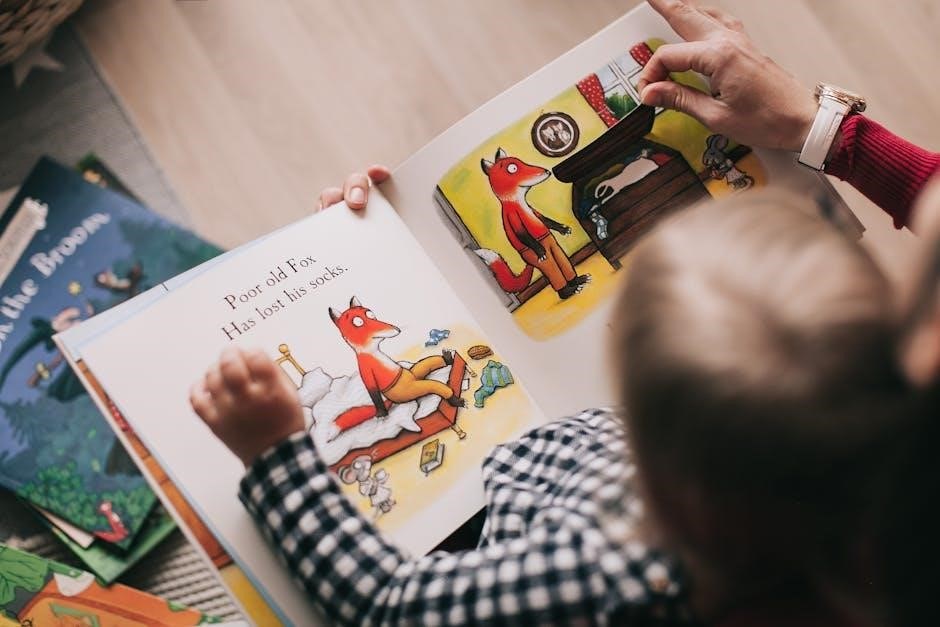
Discover engaging PDF books designed for 1st graders, fostering a love for reading and building foundational skills through colorful stories and interactive content.
Overview of the Importance of Reading for Young Learners
Reading is a cornerstone of early education, fostering vocabulary growth, comprehension, and confidence in young learners. It introduces children to diverse worlds, ideas, and cultures, sparking imagination and curiosity. For 1st graders, reading lays the foundation for academic success and lifelong learning. Engaging stories and relatable characters help build empathy and critical thinking skills. Regular reading habits cultivate a love for books, preparing children to navigate complex texts and concepts as they progress. This stage is crucial for developing a strong literacy base and a lifelong appreciation for learning.
Why PDF Format is Convenient for Accessing Books
PDF format offers unparalleled convenience for accessing books, enabling easy reading on various devices like tablets, phones, and computers. It ensures consistent formatting and high-quality visuals, preserving the integrity of illustrations in children’s books. PDFs are also space-efficient, allowing multiple books to be stored digitally without physical clutter. Additionally, PDFs are often free or low-cost, making them accessible to everyone. They can be shared easily and reused indefinitely, providing a practical solution for classrooms and homes. This format supports learning on the go, fostering flexibility and engagement for young readers.

Popular Categories of Books for 1st Graders
Picture books, early readers, and chapter books are popular choices, offering engaging stories, colorful visuals, and gradual complexity to support young learners’ reading growth and enjoyment.
Picture Books for Early Readers
Picture books are perfect for reading aloud, featuring engaging stories and vibrant illustrations that captivate young minds. They often address social-emotional learning, helping children navigate emotions and friendships. These books encourage early readers to see themselves in the stories, fostering a sense of identity and belonging. With their simple yet meaningful narratives, picture books are an excellent way to bond with your child and lay the foundation for a lifelong love of reading.
Early Reader Books for Building Confidence
Early reader books are designed with simple language and familiar themes to help young readers feel successful. These books typically feature repetition, rhyme, and predictable structures, making them ideal for building confidence. They allow children to read independently, fostering a sense of accomplishment and pride. With engaging stories and relatable characters, early reader books create a positive reading experience, encouraging children to view themselves as capable readers.
Chapter Books for Developing Reading Skills
Chapter books introduce more complex storytelling, helping 1st graders develop their reading stamina and comprehension. These books often feature a series of connected chapters, encouraging children to follow a narrative over multiple sessions. With each chapter building on the previous one, they help young readers understand plot progression and character development. Chapter books also expand vocabulary and enhance critical thinking, making them a vital step in advancing reading skills and preparing students for more challenging literature.

Best Books for 1st Graders to Read Themselves
Engage young readers with books like The Cat in the Hat, Green Eggs and Ham, and Corduroy, designed to boost confidence and independence with simple, repetitive text and vibrant illustrations.
Classic Tales That Foster Independence
Classic tales like The Cat in the Hat and Green Eggs and Ham are perfect for emerging readers. These stories use simple, repetitive text and engaging illustrations to build confidence. Dr. Seuss’s playful rhymes make reading fun and achievable, while timeless themes encourage children to explore their imagination. Such books are designed to help 1st graders feel proud of their growing reading skills, fostering a sense of independence and a lifelong love for literature. They are ideal for early readers to practice alone or with minimal guidance. These beloved stories remain foundational in many classrooms and homes, offering both entertainment and educational value. By mastering these classics, young readers gain the confidence to tackle more complex texts, making them a cornerstone of early literacy development.
Modern Stories That Engage Young Minds
Modern stories captivate young readers with fresh ideas and relatable characters. Books like The Book with No Pictures and The Bad Seed use humor and creativity to keep children engaged. These tales often address contemporary themes, such as friendship, kindness, and overcoming challenges, making them relevant to today’s learners. Vibrant illustrations and interactive elements, like sound effects or choices, enhance the reading experience. These stories not only entertain but also foster critical thinking and social-emotional learning, helping 1st graders develop a deeper connection with the material and a love for reading. They are perfect for fostering independence and confidence in young readers.
Award-Winning Titles for Emerging Readers
Award-winning books for 1st graders are carefully crafted to inspire young minds. Titles like The Book with No Pictures and The Bad Seed captivate readers with humor and creativity. These stories often tackle themes of friendship, kindness, and overcoming challenges, resonating with children’s experiences. Many of these books have received prestigious awards for their engaging narratives and illustrations. They not only entertain but also promote social-emotional learning and critical thinking. Award-winning titles are perfect for fostering a love of reading and building confidence in emerging readers.

Recommended Read-Aloud Books for 1st Graders
Engage young learners with captivating read-aloud books that foster bonding, spark discussions, and promote emotional growth through relatable stories and interactive elements.
Stories That Promote Bonding and Discussion
Heartwarming tales that spark meaningful conversations, these books create opportunities for connection between children and readers. Stories like Its Okay To Ask Questions address emotional challenges, helping kids cope with worries and fostering empathy. Interactive elements and relatable characters encourage discussion, making reading a shared experience. These narratives not only entertain but also teach valuable lessons, helping young learners develop social-emotional skills in a supportive and engaging environment.
Books That Address Social-Emotional Learning
These books are crafted to help young readers navigate emotions, empathy, and self-awareness. Stories like Its Okay To Ask Questions explore worries and coping mechanisms, while others highlight themes of friendship and kindness. By addressing real-life challenges, these narratives provide tools for children to understand and manage their feelings. Interactive elements and relatable characters make these books ideal for fostering emotional intelligence and resilience, creating a supportive environment for social-emotional growth.
Interactive Elements to Enhance Reading Sessions
Engage young readers with books featuring interactive elements like flaps, buttons, and pull-out tabs. These hands-on features encourage participation and make reading sessions dynamic. Some PDFs include clickable links to animations or audio, enhancing storytelling; Questions and prompts within the text invite children to think aloud and predict outcomes. These elements not only entertain but also deepen comprehension and make reading a shared, enjoyable experience for 1st graders and their families or educators.

Tips for Choosing the Right Books
Select books that match your child’s reading level and interests. Look for engaging stories, colorful illustrations, and age-appropriate themes to foster a love for reading and learning.
How to Identify Age-Appropriate Content
When selecting books for 1st graders, focus on themes and language suitable for their developmental stage. Check reading levels, such as Grade Level or Lexile measures, to ensure texts are accessible. Avoid books with complex vocabulary or mature themes. Opt for stories with relatable characters and simple, engaging plots. Use book reviews and educator recommendations to guide your choices; Ensure content aligns with the child’s interests and maturity, fostering both enjoyment and learning. Interactive elements like rhymes or puzzles can enhance engagement and understanding.
Encouraging a Love for Reading Through Diversity
Exposing 1st graders to diverse books fosters empathy and broadens their understanding of the world. Choose stories featuring varied cultures, characters, and experiences to spark curiosity. Include themes like friendship, family, and overcoming challenges to resonate with their lives. Diverse books help children see themselves reflected and explore new perspectives, making reading more engaging and inclusive. This approach nurtures a lifelong love for reading while promoting cultural awareness and social-emotional growth.
Using Book Reviews and Recommendations
Book reviews and recommendations are invaluable tools for selecting the right books for 1st graders. Trusted sources like educators, parents, and literary websites provide insights into engaging and age-appropriate stories. Platforms often highlight books with diverse themes, relatable characters, and educational value. Reading reviews helps identify titles that align with your child’s interests and reading level. Recommendations also uncover hidden gems and award-winning books that can spark a lifelong love for reading. Use these resources to make informed choices and discover stories that resonate with young learners.

Benefits of Reading Books for 1st Graders
Reading enhances vocabulary, sparks imagination, and builds confidence in young learners. It fosters a lifelong love for reading and lays the foundation for future academic success.
Improving Vocabulary and Comprehension
Reading books introduces 1st graders to new words, simple sentences, and engaging stories, expanding their vocabulary. Picture books and early readers use repetitive phrases and context clues, helping children understand meanings. Comprehension grows as they connect words with pictures and relate stories to their experiences. Interactive elements like puzzles and discussions further enhance their ability to interpret and retain information, building a strong foundation for future reading success and academic growth.
Developing Critical Thinking and Creativity
Books for 1st graders often feature engaging stories and imaginative plots that encourage children to think creatively. Interactive elements like puzzles and open-ended questions prompt young readers to explore different possibilities. Stories with relatable characters and challenges inspire problem-solving skills, fostering critical thinking. Discussing books with others helps children articulate their thoughts and consider diverse perspectives. This nurturing of creativity and analytical skills lays the groundwork for lifelong learning and intellectual growth, making reading a powerful tool for cognitive development in early childhood.
Building Confidence and Self-Esteem
Books tailored for 1st graders often feature relatable characters and uplifting stories that help children overcome fears and challenges. Reading about protagonists who succeed despite obstacles inspires young readers to believe in their abilities. Interactive elements and predictable storylines build a sense of mastery, fostering confidence. Books that celebrate individuality and perseverance empower children to view themselves as capable learners, laying a strong foundation for self-esteem and a positive self-image that extends beyond the classroom.

Resources for Finding Free PDF Books
Explore websites offering free educational resources, libraries, and digital platforms to download PDF books for 1st graders, ensuring convenient and legal access to quality reading materials.
Websites Offering Free Educational Resources
Several websites provide free PDF books for 1st graders, including Project Gutenberg, ManyBooks, and Google Books. These platforms offer classic tales, modern stories, and interactive books. Additionally, educational websites like OpenStax and Scribd feature a variety of children’s books. Some sites allow filtering by age and reading level, ensuring appropriate content. Many libraries also offer free e-books for young readers. Always verify the legality and safety of downloads to ensure a secure and enjoyable reading experience for your child.
Libraries and Digital Platforms for Download
Public libraries and digital platforms like OverDrive, Scribd, and Hoopla offer free access to PDF books for 1st graders. Many libraries partner with schools to provide e-books tailored for early readers. These platforms often feature interactive elements and adjustable font sizes, making reading engaging. Parents and educators can easily download books for offline access, ensuring availability anytime. Additionally, platforms like Epic! and Reading A-Z cater specifically to children, offering curated lists of age-appropriate books. These resources support learning and make reading convenient and enjoyable for young students.
Guidelines for Safe and Legal Downloads
When downloading PDF books for 1st graders, ensure you use reputable sources like official websites or trusted platforms. Always verify the legal status of downloads in your region. Avoid pirated content to support authors and publishers. Use strong, unique passwords for accounts and enable two-factor authentication. Regularly update your antivirus software to scan downloaded files. Be cautious of suspicious links and avoid sharing downloaded content illegally. Respect copyright laws and promote a culture of legal and ethical access to educational materials.

Engaging Reading Activities for 1st Graders
Create a cozy reading nook, host book clubs, and incorporate games or puzzles related to the stories to make reading fun and interactive for young learners.
Creating a Cozy Reading Corner
A cozy reading corner is essential for fostering a love of reading in 1st graders. Use pillows, soft lighting, and colorful decorations to create a inviting space. Incorporate favorite books and stuffed animals to make it personalized. This setup encourages independent reading and helps children associate reading with comfort and joy. A well-designed reading nook can become their go-to spot for exploring stories and developing a lifelong love for books. Make it a special place where imagination and learning thrive naturally.
Hosting Book Clubs or Reading Groups
Hosting book clubs or reading groups for 1st graders is a great way to foster a sense of community and shared learning. Choose a book that aligns with their interests and reading level, then guide discussions to encourage critical thinking and comprehension. Rotate roles like leader, summarizer, and illustrator to keep everyone engaged. Make it fun with snacks, games, and activities tied to the story. This collaborative approach not only enhances reading skills but also builds teamwork and social confidence, helping children bond over a shared love of stories.
Incorporating Games and Puzzles Related to Books
Incorporate games and puzzles tied to books to make reading sessions interactive and fun for 1st graders. Word searches, crosswords, and matching games featuring story characters or themes can enhance engagement. Use apps or online tools to create digital activities that complement PDF books. These exercises improve problem-solving skills and hand-eye coordination while reinforcing story comprehension. Games like “Find the Character” or “Sequence the Story” encourage active participation, making reading a dynamic and enjoyable experience for young learners.
Fostering a lifelong love for reading, these books for 1st graders PDFs provide engaging stories and learning opportunities, nurturing young minds and sparking imagination for future growth.
Final Thoughts on the Importance of Reading
Reading is a cornerstone of early education, fostering vocabulary, comprehension, and critical thinking. It sparks imagination, builds confidence, and creates a bond between readers. For 1st graders, accessing books in PDF format ensures convenience and accessibility, making learning fun and engaging. Diverse stories cater to different interests, promoting empathy and understanding. By nurturing a love for reading, we equip young learners with skills that last a lifetime, setting the stage for future academic success and a lifelong appreciation of knowledge.
Encouraging Lifelong Learning Through Books
Introducing children to diverse stories early fosters a lifelong love for learning. Books for 1st graders, especially in PDF format, offer accessibility and convenience, making reading a daily joy. From picture books to early chapter books, these stories spark curiosity and imagination. By engaging with various genres and themes, children develop empathy, critical thinking, and a deeper understanding of the world. Encourage daily reading habits, discussions, and exploration of new titles to cultivate a passion for knowledge that will grow with them throughout their lives.



